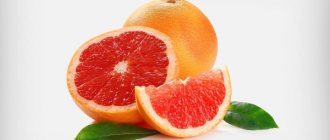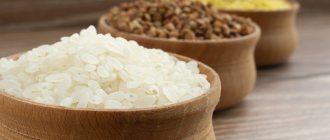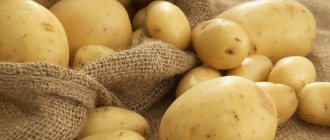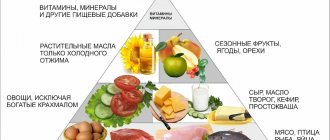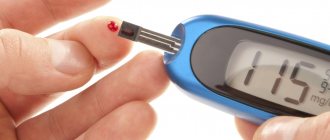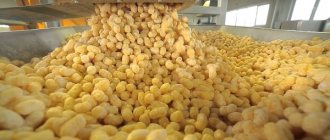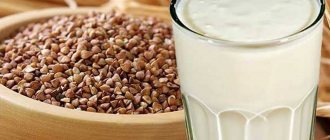What happens in the body when you eat carbohydrates
Any food consumed by a person is processed into macro- and microcomponents. Carbohydrates are converted to glucose. This process of converting complex products into “small” substances is controlled by insulin.
There is an inextricable connection between incoming carbohydrates, blood glucose and insulin. Carbohydrates entering the body are processed by digestive juices and enter the blood in the form of glucose. At this time, the hormone that controls the entry of glucose is on guard at the “gate” of insulin-dependent tissues and organs. It can be used to produce energy, or it can be stored in adipose tissue for later.
In diabetics, the physiology of this process is disrupted. Either not enough insulin is produced, or the cells of the target organs (insulin-dependent) become insensitive to it. In both cases, glucose utilization is impaired, and the body requires outside help. For these purposes, insulin or hypoglycemic agents are administered (depending on the type of diabetes)
However, it is equally important to keep incoming substances under control, so treatment with diet is just as necessary as taking medications.
Drinks, juices
| The product's name | Amount of product in 1 XE |
| Coca-Cola, Sprite, Fanta, etc. | 100 ml (0.5 cup) |
| Kvass / Kissel / Compote | 200-250 ml (1 glass) |
| Orange juice | 100 ml (0.5 cup) |
| Grape juice | 70 ml (0.3 cups) |
| Cherry juice | 90 ml (0.4 cups) |
| Grapefruit juice | 140 ml (1.4 cups) |
| Pear juice | 100 ml (0.5 cup) |
| Cabbage juice | 500 ml (2.5 cups) |
| Strawberry juice | 160 ml (0.7 cups) |
| Redcurrant juice | 90 ml (0.4 cups) |
| Gooseberry juice | 100 ml (0.5 cup) |
| Raspberry juice | 160 ml (0.7 cups) |
| carrot juice | 125 ml (2/3 cup) |
| Cucumber juice | 500 ml (2.5 cups) |
| Beet juice | 125 ml (2/3 cup) |
| Plum juice | 70 ml (0.3 cups) |
| Tomato juice | 300 ml (1.5 cups) |
| Apple juice | 100 ml (0.5 cup) |
What do XE show?
- The number of bread units reflects how much blood glucose will be obtained from the food taken. Knowing how much mmol/l the glucose concentration will increase, you can more accurately calculate the dose of insulin required.
- Counting bread units allows you to estimate the value of food.
- XE is an analogue of a measuring stick that allows you to compare different food products. The question that bread units answer is: how many of these or other foods will contain exactly 12 g of carbohydrates?
Thus, taking into account bread units, it is easier to adhere to diet therapy for type 2 diabetes.
How to use XE?
The number of bread units in various products is recorded in the table. Its structure looks like this: the names of the products are listed in one column, and the number of grams of this product per 1 XE is listed in the other. For example, 2 tablespoons of the most common cereals (buckwheat, rice and others) contain 1 XE.
Another example is strawberries. To get 1 XE, you need to eat about 10 medium strawberries. For fruits, berries and vegetables, the table most often shows quantitative indicators in pieces.
Another example, with a finished product.
100 g of Yubileiny cookies contain 66 g of carbohydrates. One cookie weighs 12.5 g. This means that one cookie will contain 12.5 * 66 / 100 = 8.25 g of carbohydrates. This is slightly less than 1 XE (12 g of carbohydrates).
Formula for calculating carbohydrates:
The amount of carbohydrates in 100 grams of product (indicated on the package) - N
Total weight of the product in the dish - D
(N*D/100)/12=XE (number of bread units in the dish).
Dairy
| The product's name | Amount of product in 1 XE |
| Milk (any fat content) | 1 glass (200-250 ml) |
| Kefir (any fat content) | 1 glass (200-250 ml) |
| Yogurt, Ryazhenka | 1 glass (200-250 ml) |
| Curd mass without additives | 100 gr |
| Curd mass with raisins | 40 gr |
| Condensed milk | 130 ml |
| Cream (any fat content) | 1 glass (200-250 ml) |
| Natural unsweetened yogurt | 1 glass (200-250 ml) |
| Fruit yoghurt | 80-100 gr |
| Children's glazed cheese curds | 35 gr |
| Cheesecake (medium size) | 1 PC. (75 gr) |
| Ice cream (without frosting and waffles) | 65 gr |
| Creamy ice cream (with glaze) | 50 gr |
Consumption rate
How many bread units should be consumed per meal and throughout the day depends on age, gender, weight and physical activity.
It is recommended to calculate your food intake so that it contains about 5 XE. Some norms of bread units per day for adults:
- People with a normal BMI (body mass index) with sedentary work and a sedentary lifestyle - up to 15-18 XE.
- People with a normal BMI in occupations requiring physical labor - up to 30 XE.
- Patients with overweight and obesity with low physical activity - up to 10-12 XE.
- People with excess body weight and high physical activity - up to 25 XE.
For children, depending on age, it is recommended to use:
- at 1-3 years – 10-11 XE per day;
- 4-6 years – 12-13 HE;
- 7-10 years – 15-16 HE;
- 11-14 years old – 16-20 HE;
- 15-18 years old – 18-21 HE.
At the same time, boys should receive more than girls. After 18 years of age, the calculation is made in accordance with adult values.
Table of bread units
In order to calculate how many bread units a particular product or dish contains, this table is used.
Bread units are used to calculate carbohydrates in meals and are used in various diets, as well as to determine the amount of insulin for diabetics. 1 unit of bread equals 12 grams of carbohydrates.
| Cereals, cereals, flour products | ||
| The product's name | Quantity per 1 x | Volume, weight on 1x |
| Wholemeal rye bread | 1 piece 1.5 cm thick | 35 g |
| White, gray bread (except butter bread) | 1 piece 1.5 cm thick | 20 g |
| Black bread | 1 piece 1 cm thick | 25 g |
| Bran bread | 1 piece 1.3 cm thick | 30 g |
| Borodinsky, Riga, aromatic bread | 1 piece 0.6 cm thick | 15 g |
| Rye bread | 1 piece 1 cm thick | 25 g |
| Crispbread | 2 pieces | 20 g |
| Breadsticks | quantity depends on size | 20 g |
| Unsweetened crackers | 2 pieces | 20 g |
| Unsweetened dryers | 1.5-2 pieces | 20 g |
| Crackers 1 large 2 medium 3 small | 2 pieces 5 pieces 15 pieces | 20 g 20 g 20 g |
| Pita | 20 g | |
| Butter bun | 20 g | |
| Frozen puff pastry | 35 g | |
| Frozen yeast dough | 25 g | |
| Damn thin | 1 large | 30 g |
| Frozen pancakes with cottage cheese | 1 PC | 50 g |
| Frozen empanadas | 1 PC | 50 g |
| Frozen dumplings with cottage cheese | 4 things | 50 g |
| Frozen dumplings | 4 things | 50 g |
| Cheesecake | 50 g | |
| Wafers are small | 1.5 pcs | 17 g |
| Flour | 1 tbsp. heaped spoon | 15 g |
| Gingerbread | 1/2 pcs | 40 g |
| Pancakes | 1 medium | 30 g |
| Breadcrumbs | 1 tbsp. heaped spoon | 15 g |
| Butter cookies | 1-2 pieces depending on size | 15 g |
| Any raw cereal | 1 tbsp. heaped spoon | 15 g |
| Any porridge | 2 tbsp. heaped spoons | 50 g |
| Cereals | 2 tbsp. heaped spoons | 15 g |
| Wheat bran | 12 tbsp. spoons | 50 g |
| Pasta | depending on the form from 1 to 4 tbsp. spoons | 15 g |
| Boiled pasta | depending on the shape from 2 to 4 spoons | 50 g |
| Potatoes and mature legumes, some types of vegetables | ||
| The product's name | Quantity per 1 x | Volume, weight on 1x |
| Dried beans | 1 tbsp. spoon | 20 g |
| Boiled beans | 3 tablespoons | 50 g |
| Peas (brain) canned | 6 tbsp. spoons | 100 g |
| Jacket potatoes | 1 PC. | 75 g |
| Frozen potato pancakes | 60 g | |
| Potatoes, raw, boiled | 1 PC. (about the size of a large egg) | 65 g |
| Mashed potatoes | 2 tbsp. spoons | 75 g |
| Fried potato | 1.5-2 tbsp. spoons depending on the cut | 35 g |
| French fries | 12 slices | 35 g |
| Potato chips | 1 small sachet | 25 g |
| Corn (cob) | 0.5 pcs | 100 g |
| Canned corn | 3 tbsp. spoons | 70 g |
| Boiled corn | 3 tbsp | 50 g |
| Cornflakes | 4 tbsp | 15 g |
| Carrot | 3 large | 400 g |
| Beet | 2 large | 400 g |
| Boiled beans | 3 tbsp | 50 g |
| Boiled lentils | 2 heaped tablespoons | 50 g |
| Pumpkin | 200 g | |
| Ketchup | 2-3 tbsp. spoons | 30 – 50 g |
| Jerusalem artichoke | 70 g | |
| Dried soybeans | 4 tbsp. spoons | 45 g |
| Dairy | ||
| The product's name | Quantity per 1 x | Volume, weight on 1x |
| Milk | 1 glass | 200 ml |
| Kefir | 1 glass | 250 ml |
| Baked milk | 1 glass | 200 ml |
| Kefir bifidok | 1 glass | 250 ml |
| Acidophilus sweet | 1/2 cup | 100 ml |
| Natural unsweetened yogurt (bio) | 1 glass | 250 ml |
| Fruit yoghurt | 75-100 g | |
| Cream | 1 glass | 200 ml |
| Buttermilk | 1 glass | 300 ml |
| Curdled milk | 1 glass | 200 ml |
| Ryazhenka | 1 glass | 200 ml |
| Milk ice cream (without glaze and waffles) | 65 g | |
| Creamy ice cream (in glaze or waffles) | 50 g | |
| Condensed milk without sugar (can volume 400 g) | 1/3 can | 130 g |
| Powdered milk powder | 1 tbsp. spoon | 30 g |
| Cheesecake medium (with sugar) | 1 piece | 75 g |
| Sweet curd mass (without glaze and raisins) | 100 g | |
| Children's glazed cheese curds | 2/3 pieces | 35 g |
| Curd mass with raisins (sweet) | 35-40 g | |
| Fruits and berries | ||
| The product's name | Quantity per 1 x | Volume, weight on 1x |
| Apricot | medium large | 120 g 100 g |
| Avocado | 1 PC | 2000 g |
| Quince | large 1 piece | 140 g |
| Cherry plum | 4 things | 140 g |
| A pineapple | 1 slice with peel, cross section | 140 g |
| Orange | with peel small 1 piece | 130 g |
| Watermelon | 1 slice with peel | 270 g |
| Banana | medium 1/2 pcs | 70 g |
| Cowberry | 7 tbsp. l. (or 1 glass) | 140 g |
| Grape | medium 10 pcs | 70 g |
| Cherry | large 15 pcs | 90 g |
| Pomegranate | large 1 piece | 170 g |
| Grapefruit | large 1/2 pcs | 170 g |
| Pear | medium 1 piece | 100 g |
| Melon - “collective farmer” | 1 slice with peel | 100 g |
| Blackberry | 8 tbsp. l. (or 1 glass) | 140 g |
| Strawberries | 8 tbsp. l. (or 1 glass) | 150 g |
| Figs | large raw 1 piece | 80 g |
| Kiwi | large 1 piece | 110 g |
| Strawberry | average 10 pcs | 160 g |
| Cranberry | 1 glass | 160 g |
| Gooseberry | 1 glass | 120 g |
| Lemon | 3 pcs | 270 g |
| Raspberries | 8 tbsp. l. (or 1 glass) | 150 g |
| Mango | small 1 piece | 11 g |
| Tangerines | small 3 pcs with peel 2 pcs without peel | 150 g 120 g |
| Nectarine | average | 120 g |
| Peach | average | 120 g |
| Papaya | 1/2 pcs | 140 g |
| Blue plums | medium 3 pcs small 4 pcs | 90 g 90 g |
| Currant | 7 tbsp. l. (or 1 glass) | 140 g |
| Feijoa | medium 10 pcs | 160 g |
| Persimmon | medium 1 piece | 70 g |
| Cherries | 10 pcs (or 1 glass) | 100 g |
| Blueberry | 7 tbsp. (or 1 glass) | 140 g |
| Rosehip (fruit) | 3 tbsp. l. with a slide | 60 g |
| Apple of any color | average 1 piece | 90 g |
| Natural vegetable juices: | ||
| cabbage | 2.5 cups | 500 g |
| carrot | 2/3 cup | 125 g |
| cucumber | 2.5 cups | 500 g |
| beetroot | 2/3 cup | 125 g |
| tomato | 1.5 cups | 300 g |
| Fruit and berry juices (100%) | ||
| orange | 0.5 cups | 110 g |
| grape | 0.3 cups | 70 g |
| cherry | 0.4 cup | 90 g |
| pear | 0.5 cups | 100 g |
| grapefruit | 1.4 cups | 140 g |
| redcurrant | 0.4 cup | 80 g |
| gooseberry | 0.5 cups | 100 g |
| strawberry | 0.7 cups | 100 g |
| crimson | 0.75 cups | 170 g |
| plum | 0.35 cups | 80 g |
| apple | 0.5 cups | 100 g |
| Sweets and other products | ||
| The product's name | Quantity per 1 x | Volume, weight on 1x |
| Sugar jam | 1 tbsp. l. | 10 g |
| Sweet carbonated water Pepsi - Cola, Coca-Cola, Sprite, Fanta, etc. | 1/2 cup | 100 g |
| Caramel | 4-6 pcs | |
| Kvass | 1 glass | 250 g |
| Kissel | 1 glass | 250 g |
| Compote | 1 glass | 250 g |
| Chocolate candy | 1 PC | 16 g |
| Dried fruits, bananas, raisins, figs, dried apricots, dates, prunes, apples | 1 piece 1 0 pieces 1 piece 3 pieces (or 6 slices) 2 pieces 3 pieces 2 tbsp. Spoons | 15 g 15 g 15 g 15 g 15 g 20 g 20 g |
| Honey | 1 tbsp. l. | 10-12 g |
| Nuts | ||
| walnuts (peeled) | b.l. with a slide | 90 g |
| earthen | 40 pcs with peel 1/4 tbsp without peel | 80 g 60 g |
| cedar | 1/4 tbsp | 60 g |
| cashew | 2 tbsp. l | 40 g |
| coconut | 1 slice | 11 g |
| coconut crumbs | 1.5 tbsp | 100 g |
| almond | 3/4 tbsp | 65 g |
| pistachios | 1/2 tbsp | 60 g |
| hazelnut (forest) | 3/4 tbsp | 90 g |
| southern (Brazilian) | 3/4 tbsp | 110 g |
| Pudding | 125 g | |
| Marmalade | 20 g | |
| Regular light beer | 300 g | |
| Non-alcoholic | 200 g | |
| Lump sugar | 2 pieces | 10 g |
| Granulated sugar | 1 tbsp. l | 10 g |
| Fructose | 1 tbsp. l | 12 g |
| Regular chocolate | 1/5 tile | 20 g |
| with sweetener | 1/3 tile | 30 g |
| McDonald's | ||
| Hamburger double | 3 XE | |
| Big Mag triple | 4 XE | |
| A bag of potatoes | small | 1 XE |
| Pizza | 300 g | 6 XE |
| Cake pie | 1 piece | 3-8 XE |
Calculation of insulin units
Eating by bread units is not only about calculating the amount of food. They can also be used to calculate the number of units of insulin to be administered.
After eating a meal containing 1 XE, blood glucose increases by approximately 2 mmol/l (see above). The same amount of glucose requires 1 unit of insulin. This means that before eating you need to count how many units of bread there are in it and administer the same number of units of insulin.
However, not all so simple. It is advisable to measure blood glucose. If hyperglycemia is detected (>5.5), then more insulin needs to be administered, and vice versa - with hypoglycemia, less insulin is needed.
Example
Before lunch, which contains 5 XE, a person was diagnosed with hyperglycemia - the blood glucose level was 7 mmol/l. To reduce glucose to normal values, you need to take 1 unit of insulin. In addition, 5 XE remain, which will come from food. They are “neutralized” by 5 units of insulin. Therefore, a person needs to administer 6 units before lunch.
What should not be included in the diet?
In no case should we forget that there are foods whose consumption in diabetes is strictly prohibited (or maximally limited).
Prohibited products include:
- both butter and vegetable oils;
- milk cream, sour cream;
- fatty fish or meat, lard and smoked meats;
- cheeses with fat content more than 30%;
- cottage cheese with a fat content of more than 5%;
- bird skin;
- various sausages;
- canned food;
- nuts or seeds;
- all sorts of sweets, be it jam, chocolate, cakes, various cookies, ice cream and so on. These include sweet drinks;
- and alcohol.
